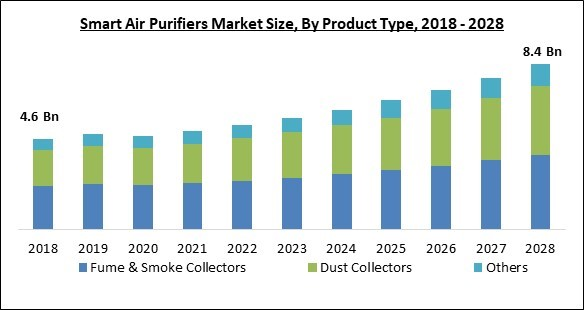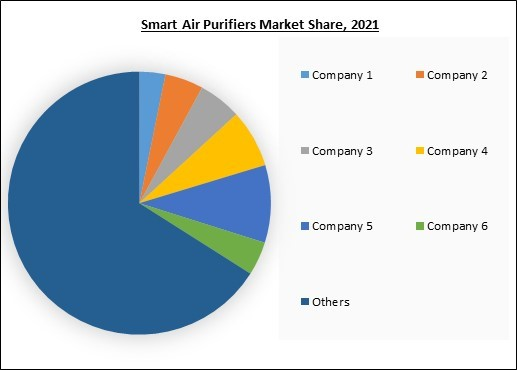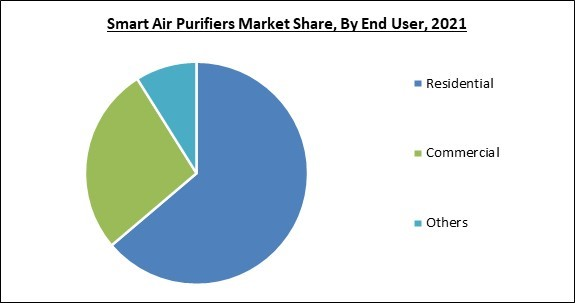The Global Smart Air Purifiers Market size is expected to reach $8.4 billion by 2028, rising at a market growth of 7.9% CAGR during the forecast period.
Air purifier devices have been around for a long time. Certain air purifiers called smart air purifiers now come equipped with Wi-Fi capabilities, due to technological advancements. This means users don't have to manually turn it on and off or check the filters to make sure they're clean; instead, they are able to control and monitor the purifier from their phone.
Dust, dust mites, pet dander, mold, smoke particles, car exhaust, kitchen smoke, and gaseous pollutants are all removed by air purifiers. Smart air purifiers use a smartphone-enabled app to monitor and adjust air quality, as well as to provide real-time readings of quality data. The gadget also allows users to measure indoor air quality over time, allowing them to see when the time of day has the best and worst air quality. The use of smart air filtration and purifier solutions is expected to increase as air quality continues to deteriorate due to high smoking, pollution, and PM2.5 levels.
The World Health Organization (WHO) estimates that 9 out of 10 people breathe contaminated air with high levels of contaminants. According to the report, roughly 7 million people die prematurely each year as a result of outdoor and interior air pollution, with 3.8 million dying as a result of indoor air pollution. Over the projected period, the smart air purifiers market is expected to be driven by deteriorating air quality across regions and increased awareness about the benefits of using air purifiers.
Indoor pollutants and PM2.5 levels above a certain threshold increase the risk of respiratory disorders, heart disease, cancer, dizziness, fatigue, asthma, and eye irritation, among other ailments. To address the increased demand, manufacturers concentrate on product innovation and new product releases.
The leading players in the market are competing with diverse innovative offerings to remain competitive in the market. The below illustration shows the percentage of revenue shared by some of the leading companies in the market. The leading players of the market are adopting various strategies in order to cater demand coming from the different industries. The key developmental strategies in the market are Product Launches.
The market research report covers the analysis of key stake holders of the market. Key companies profiled in the report include Dyson Limited, Honeywell International, Inc., Xiaomi Corporation, LG Electronics, Inc. (LG Corporation), Koninklijke Philips N.V., Sharp Corporation, Unilever PLC, Coway Co., Ltd., and Levoit (Vesync Co., Ltd.)
By Technique
Air purifier devices have been around for a long time. Certain air purifiers called smart air purifiers now come equipped with Wi-Fi capabilities, due to technological advancements. This means users don't have to manually turn it on and off or check the filters to make sure they're clean; instead, they are able to control and monitor the purifier from their phone.
Dust, dust mites, pet dander, mold, smoke particles, car exhaust, kitchen smoke, and gaseous pollutants are all removed by air purifiers. Smart air purifiers use a smartphone-enabled app to monitor and adjust air quality, as well as to provide real-time readings of quality data. The gadget also allows users to measure indoor air quality over time, allowing them to see when the time of day has the best and worst air quality. The use of smart air filtration and purifier solutions is expected to increase as air quality continues to deteriorate due to high smoking, pollution, and PM2.5 levels.
The World Health Organization (WHO) estimates that 9 out of 10 people breathe contaminated air with high levels of contaminants. According to the report, roughly 7 million people die prematurely each year as a result of outdoor and interior air pollution, with 3.8 million dying as a result of indoor air pollution. Over the projected period, the smart air purifiers market is expected to be driven by deteriorating air quality across regions and increased awareness about the benefits of using air purifiers.
Indoor pollutants and PM2.5 levels above a certain threshold increase the risk of respiratory disorders, heart disease, cancer, dizziness, fatigue, asthma, and eye irritation, among other ailments. To address the increased demand, manufacturers concentrate on product innovation and new product releases.
COVID-19 Impact Analysis
Due to the COVID-19 pandemic, many companies in the smart air purifiers industry were compelled to temporarily suspend operations in order to comply with new government rules aimed at preventing the disease's spread. This suspension in operations had a direct influence on the air filter market's revenue flow. In addition, due to a scarcity of raw materials and people during the lockdown, the manufacturing of industrial products has come to a halt. Furthermore, enterprises in this industry did not get any fresh consignments. As a result, the suspension of industrial activities and the subsequent lockdown for several months had an impact on the market share of smart air purifiers, and the market is expected to recover slowly during the projection period.Market Growth Factors
Rising Pollution in Developing Countries
Developing countries such as China and India have very pollution levels and many areas in these countries have extremely high air quality index levels. Thus, residents of these areas are expected to install air purifiers in their homes to at least keep the indoor air clean and fresh. The market is expected to develop due to the rising demand for anti-pollution goods as pollution levels rise. The rising prevalence of airborne infections is expected to accelerate product adoption in the near future in developing countries. Cleaning the air using an air purifier also helps to clean the rest of the house. Pollen, mold spores, dust mites, human skin cells, hair, and insect debris are among the airborne particles that make up dust, and air purifiers with a HEPA filter may trap them.The leading players in the market are competing with diverse innovative offerings to remain competitive in the market. The below illustration shows the percentage of revenue shared by some of the leading companies in the market. The leading players of the market are adopting various strategies in order to cater demand coming from the different industries. The key developmental strategies in the market are Product Launches.
Allergies and Asthma are controlled by air purifiers
Mold, pet dander, pollen, and germs are all airborne particles that can cause allergies and asthma episodes. Indoor air quality can be up to five times worse than outside air quality, according to the US Environmental Protection Agency. As a result, having a top-quality True HEPA filter in the house can help regulate allergies and asthma by reducing the number of allergens and asthma-inducing particles in the air one breathes. This benefit has led to an increase in the demand for smart purifiers. Many common household products can potentially release dangerous pollutants into the air for up to two years. Building supplies, adhesives, wall paint, furniture, and cleaners are all examples.Market Restraining Factors
Air Purifiers are Take up a Lot of Space and Make Noise and Some Produce Ozone
Air purifiers create some noise, even if it is not excessive, and one should assess how much noise one can endure. Especially if one wants to use it for anything like working from their home office. The sound level of a quiet air purifier is usually between 30 and 40 dB. To mild rainfall, this is roughly as loud as a whisper. Some air purifiers, on the other hand, can produce up to 70 decibels, which is comparable to traffic noise and will undoubtedly be an annoyance. An air purifier's noise and light might be distracting, especially late at night when someone is attempting to sleep. Some air purifiers are rather large, and they can be a nuisance.Technique Outlook
Based on Technique, the market is segmented into High-efficiency Particulate Air (HEPA), Activated Carbon Filtration, Thermodynamic Sterilization System (TSS), Ultraviolet Germicidal Irradiation, Ionizer Purifiers, and Others. The high-efficiency particulate air (HEPA) segment acquired the largest revenue share in the smart air purifiers market in 2021. This is because this solution can remove 99.97 percent of pollutant particles. HEPA is a sort of mechanical filter that traps hazardous particles such as pollen, dust mites, tobacco smoke, and other contaminants by pulling air through a small mesh.Product Type Outlook
Based on Product Type, the market is segmented into Fume & Smoke Collectors, Dust Collectors, and Others. The dust collectors market procured a significant revenue share in the smart air purifiers market in 2021. Many air purifiers on the market are made to filter out big dust particles. Mechanical filtration, which is a method of capturing contaminants on filters, is used in many of them. The particles are either supposed to cling to the filter or get caught in the filter fibers.End User Outlook
Based on End User, the market is segmented into Residential, Commercial, and Others. The residential segment acquired the largest revenue share in the smart air purifiers market in 2021. Owing to its ease of use and great efficacy in cleaning viruses, germs, pollen, pet dander, and smoke during cooking, smart air purifiers have seen an increase in demand in the home market in recent years. Furthermore, due to rising pollution levels in cities such as India and China, the adoption of smart air purifiers in the residential sector is likely to rise in the future.Regional Outlook
Based on Regions, the market is segmented into North America, Europe, Asia Pacific, and Latin America, Middle East & Africa. North America acquired the highest revenue share in the smart air purifiers market in 2021. As people become more health concerned and aware of smart purifiers, the market in North America is growing. The establishment of national air quality standards has been linked to stringent government restrictions to enhance air quality standards, such as the Clean Air Act created by the United States Environmental Protection Agency (EPA) in 1970.The market research report covers the analysis of key stake holders of the market. Key companies profiled in the report include Dyson Limited, Honeywell International, Inc., Xiaomi Corporation, LG Electronics, Inc. (LG Corporation), Koninklijke Philips N.V., Sharp Corporation, Unilever PLC, Coway Co., Ltd., and Levoit (Vesync Co., Ltd.)
Strategies deployed in Smart Air Purifiers Market Share
- May-2022: LG Electronics launched LG PuriCare AeroTower Air Purifying Fan, an innovative product to help consumers achieve a healthier home. The product was created by LG to address the consumer demands and to give consumers cleaner, purified air that also cools to provide ultimate air flow customization for any room in the home whether it's the family room, bedroom, office or even a home gym.
- Apr-2022: Xiaomi launched Xiaomi Air Purifier 4 Pro, Xiaomi Air Purifier 4, and Xiaomi Air Purifier 4 Lite to purify the air of PM10 and PM2.5 particles. These products fell under the company's Xiaomi Air Purifier 4 series. The indoor air is riddled with pollens, which come from outdoor spaces through the windows or by being trapped on clothing, skin, and hair. These pollens can cause allergies to some. The Xiaomi Air Purifier 4 series can eliminate pollen particles and clean the indoor air.
- Dec-2021: Sharp Corporation released FX-J80 air purifier, a novel AIoT air purifier fitted with Sharps Plasmacluster Technology that eliminates dust, airborne mold, microbes, and viruses to offer clear and fresh air inside homes. The FX-J80 air purifier can be tracked and controlled with the “SHARP AIR APP” available on Apple Store and Play store, offering added ease of use to users.
- Oct-2021: Dyson released Dyson Purifier Hot+Cool and the Dyson Purifier Cool, two devices with fully-sealed HEPA 13 standard filtration. The machines are fully sealed against the passing of any unwanted particle. The air purifiers create high-pressure seals at an additional 24 critical points to stop dirty air from bypassing the filters and taking pollutants back into the room.
- Sep-2021: LG Electronics launched the newly-upgraded version of the LG PuriCare wearable air purifier. The product comes with an optional 'Ocean Black' color option and personalized accessories. This enables PuriCare to ensure efficient protection of health and breathing convenience while making it simple for users to match with their favorite work attire or casual clothing.
- May-2021: Levoit launched Levoit VeSync Core 400s, the newest addition to its award-winning Levoit Core Air Purifier Series. The product comes equipped with the latest technology and automatic adjustments and enhances the indoor air quality tremendously.
- Mar-2021: Sharp Corporation released SmartAir, a new state-of-the-art air purifier model. The product was introduced in India under a partnership with QNET. The product is equipped with IoT functionality that enables it to be connected to Wi-Fi and managed from anywhere on a smartphone through the SHARP Air mobile app. The QNET and Sharp partnership had been in existence for 6 years and has grown in strength over that period.
- Nov-2020: Honeywell launched Honeywell Electronic Air Cleaners (EACs) with UV Systems and a new line of indoor air quality (IAQ) sensors. The launch enabled Honeywell to expand its holistic Healthy Buildings Air Quality offering to assist in enhancing and measuring commercial building indoor air quality. The product improves indoor airflow and quality. The product helps in enhancing indoor air quality without changing the HVAC infrastructure.
- Oct-2020: Royal Philips launched the New Urban Living Series, air purifiers developed for urban homes. The release of the product helped Royal Philips solidify its industry-leading portfolio of air purifiers. The new urban series air purifiers address the demand for clean and healthy air at all times of the year and integrate state-of-the-art innovation.
Scope of the Study
Market Segments Covered in the Report:
By Technique
- High-efficiency Particulate Air (HEPA)
- Activated Carbon Filtration
- Thermodynamic Sterilization System (TSS)
- Ultraviolet Germicidal Irradiation
- Ionizer Purifiers
- Others
- Fume & Smoke Collectors
- Dust Collectors
- Others
- Residential
- Commercial
- Others
- North America
- US
- Canada
- Mexico
- Rest of North America
- Europe
- Germany
- UK
- France
- Russia
- Spain
- Italy
- Rest of Europe
- Asia Pacific
- China
- Japan
- India
- South Korea
- Singapore
- Malaysia
- Rest of Asia Pacific
- LAMEA
- Brazil
- Argentina
- UAE
- Saudi Arabia
- South Africa
- Nigeria
- Rest of LAMEA
Key Market Players
List of Companies Profiled in the Report:
- Dyson Limited
- Honeywell International, Inc.
- Xiaomi Corporation
- LG Electronics, Inc. (LG Corporation)
- Koninklijke Philips N.V.
- Sharp Corporation
- Unilever PLC
- Coway Co., Ltd.
- Levoit (Vesync Co., Ltd.)
Unique Offerings from the Publisher
- Exhaustive coverage
- The highest number of Market tables and figures
- Subscription-based model available
- Guaranteed best price
- Assured post sales research support with 10% customization free
Table of Contents
Chapter 1. Market Scope & Methodology
Chapter 2. Market Overview
Chapter 3. Competition Analysis - Global
Chapter 4. Global Smart Air Purifiers Market by Technique
Chapter 5. Global Smart Air Purifiers Market by Product Type
Chapter 6. Global Smart Air Purifiers Market by End User
Chapter 7. Global Smart Air Purifiers Market by Region
Chapter 8. Company Profiles
Companies Mentioned
- Dyson Limited
- Honeywell International, Inc.
- Xiaomi Corporation
- LG Electronics, Inc. (LG Corporation)
- Koninklijke Philips N.V.
- Sharp Corporation
- Unilever PLC
- Coway Co., Ltd.
- Levoit (Vesync Co., Ltd.)
Methodology

LOADING...











